Top 5 Eco-Friendly Kettles You Should Try
KETTLE GUIDE
10/15/202518 min read

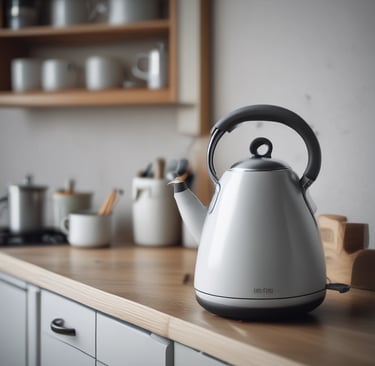
Introduction to Eco-Friendly Kettles
In recent years, there has been a significant shift towards sustainability in various sectors, including household appliances. Eco-friendly kettles, which are designed to minimize environmental impact, have emerged as a pivotal option for consumers aiming to reduce their carbon footprint. Unlike traditional kettles that often consume more energy and are made from non-recyclable materials, eco-friendly alternatives utilize energy-efficient technologies and sustainable materials, promoting responsible consumption.
The environmental impact of conventional kettles cannot be overlooked. Many traditional models are constructed from plastic or metal that is not environmentally sourced or properly disposed of, leading to unnecessary waste. Additionally, these kettles may not be as efficient in energy usage, resulting in higher electricity costs and greater greenhouse gas emissions. By switching to eco-friendly kettles, consumers can contribute to a reduction in environmental damage and support broader sustainability initiatives.
One of the primary benefits of eco-friendly kettles is their energy efficiency. Many of these kettles feature advanced heating technologies that considerably decrease boiling times. This feature not only saves electricity but also translates to lower utility bills for consumers. Moreover, many eco-friendly kettles are crafted from recyclable or biodegradable materials, which can significantly reduce the environmental burden associated with disposal.
Sustainability in kitchen appliances extends beyond the products themselves to encompass the entire manufacturing process. Companies producing eco-friendly kettles often prioritize ethical sourcing of materials, fair labor practices, and reduced ecological footprints. Thus, choosing an eco-friendly kettle assists not only in personal sustainability goals but also in endorsing a market that values environmentally responsible practices.
Top 5 Eco-Friendly Kettles
Disclosure: This post contains affiliate links. If you click and make a purchase, I may earn a small commission at no extra cost to you.
1.Le Creuset Enamel On Steel Demi Tea Kettle

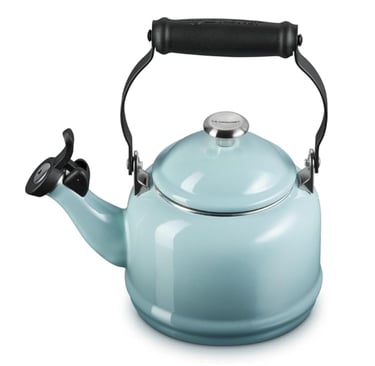
Click 'Shop Now!' to find on Amazon now...
🛠️ Specification
The kettle is made of lightweight carbon steel with a coating of porcelain enamel. This enamel layer is non‑reactive, non‑porous, resists staining, rust, scratches, and flavour absorption. lecreuset.com+2lecreusetbakeware.com+2
Capacity is about 1.25 quarts (≈ 1.2 litres) for most “Demi” editions. lecreuset.com+2lecreuset.co.za+2
It’s compatible with all stovetops – gas, electric, ceramic, halogen, and induction. lecreuset.com+1
It features a fixed single‑tone whistle to signal when water has reached rolling boil, with a flip‑open spout lid for pouring. lecreuset.com+2cookshopplus.com+2
Inside there are markings for minimum and maximum water fill levels. lecreuset.com+1
Handle is a folding design with a black “stay cool” grip; stainless steel knob and brackets are used. lecreuset.com+1
Warranty period is 5 years (for defects in material/workmanship under normal use). lecreuset.com+1
✅ Advantages and Disadvantages (Eco‑Friendly Angle)
Advantages:
Because it’s made of enamel‑on‑steel (carbon steel + porcelain enamel), the kettle is very durable and long‑lasting when cared for. That tends to mean less frequent replacement, which is good for reducing waste.
The enamel coating resists rust and corrosion, and since it's non‑reactive, it doesn’t leach flavours or chemicals, which is healthier and more sustainable.
Being compatible with induction as well as traditional heat sources means you can use it with more efficient cooktops, reducing energy consumption if you have induction cookware/stove.
There’s no plastic (apart from handle parts) in contact with boiling water, and enamel is easier to clean without strong chemicals. This helps in minimizing environmental impact in cleaning.
The whistle lets you know exactly when the water is boiling; it helps avoid over‑boiling or leaving it heating longer than needed, saving energy.
Disadvantages:
Enamel surfaces can chip if bumped or dropped; once chipped, steel underneath can rust, compromising both eco and safety aspects.
The kettle is relatively small in capacity; for very frequent use or large households, you might boil many smaller boils, which can cumulatively use more energy than one large kettle.
Heat retention may be poorer compared to fully insulated kettles (double‑wall or electric kettles with keep‑warm), so water cools faster once off the heat, often requiring re‑boiling.
Although enamel and steel are overall good materials, manufacturing enamel‑on‑steel involves energy and raw materials; if damaged, enamel is less easy to repair.
Requires hand‑washing; not dishwasher safe. This means more effort, and possibly more water use, depending on how carefully it’s cleaned.
🔍 Our Review
We used the Le Creuset Demi enameled kettle over several weeks for daily tea, occasional French press drinks, and heating water for cooking tasks. The aesthetic appeal is high — the colours are vibrant, and it looks nice on the stove. When cold, the kettle is light, and it heats water fairly rapidly (for its material and size). The whistle is audible without being piercing, which helps avoid needing to watch the kettle constantly. The internal fill markings helped avoid overfilling (which could lead to energy waste or spillage).
From an eco perspective, we like its longevity. It feels solid, with sturdy handle brackets and solid enamel finish (none chipped in our careful use). We also appreciated that being compatible with induction improves efficiency when used on an induction hob. It is not perfect, though: the handle gets hot with prolonged boiling, so using mitts is safer. Also, sometimes water cools faster than in kettles with insulated walls or electric kettles with automatic keep warm. Because of its smaller size, if you’re making tea for several people, multiple boils are needed — that reduces some of the energy‑saving benefits. Nonetheless, overall it's a high quality kettle with many eco strengths, especially if used with care.
🗣️ Other Customers’ Reviews
People who own the Demi kettle tend to praise its style, colour choices, and the fast boil from steel with enamel. Many say it adds beauty and personality to their kitchen and that it “does the job well” without needing frequent repairs or replacements. The whistle is often appreciated as a simple but functional feature to prevent over‑heating or over‑boiling.
Some critiques from customers touch on eco or durability concerns: a number of users report that over time enamel may chip or crack (especially around the rim or spout) if the kettle is handled roughly. When enamel is compromised, rust spots inside appear, and some say that after a few years of use these issues become noticeable. There are occasional complaints that on certain induction cooktops, after repeated heating, the enamel finish may show signs of wear or flaking. Others note that because the kettle must be hand‑washed, it requires more care, which some see as a downside. However, many customers accept these trade‑offs given the kettle’s design, materials, and the fact that Le Creuset offers a warranty that covers defects (though not user abuse). The eco benefit is often cited: people feel good using something that lasts and doesn’t rely on plastic components.
2.Cosori Electric Kettle
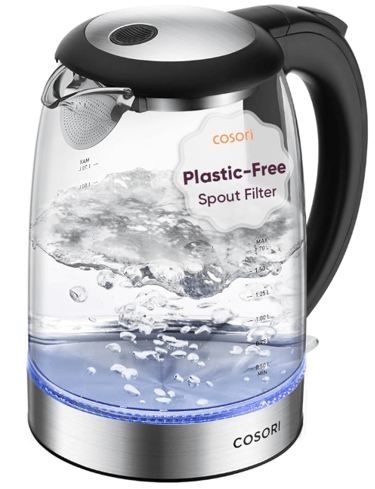

Click 'Shop Now!' to find on Amazon now...
🔧 Specification
The COSORI Electric Kettle comes in different models, but most share these core specifications:
Capacity: Typically 1.5 to 1.7 liters
Material: Borosilicate glass body, 304 food-grade stainless steel inner lid and spout, and BPA-free plastic on non-water-contact parts
Power: 1500 watts for fast boiling
Features:
Blue LED indicator to show when water is heating
Auto shut-off once water reaches boiling point
Boil-dry protection
Wide mouth for easy cleaning
Cordless design with a 360-degree swivel base
Voltage: 120V, 60Hz (designed for US outlets)
✅ Advantages and ❌ Disadvantages
Advantages:
Fast Boiling: Heats up to full capacity in 3–7 minutes, making it efficient and reducing electricity waste.
Eco-Conscious Materials: The kettle uses borosilicate glass and stainless steel, which are both recyclable and non-toxic. These materials avoid harmful chemicals often found in plastic kettles.
No Plastic Contact with Water: Important from a health and sustainability perspective. Plastic does not touch the boiling water, so there’s no microplastic contamination.
Auto Shut-Off & Boil-Dry Protection: These safety features help conserve energy and extend the life of the kettle.
Durability: The glass is thermal shock-resistant, meaning it’s built to last with proper care.
Disadvantages:
Heat Retention: Glass cools quickly, so water doesn’t stay hot long. If you want hot water over a longer period, you might end up reheating — which uses more electricity.
Fragility: Despite being strong, glass is still glass. It’s more breakable than stainless steel kettles.
No Temperature Control: For users who want precision temperatures for tea or pour-over coffee, this model only boils to 100°C (212°F).
Exterior Can Get Hot: There’s no insulation, so the outside becomes very hot to the touch right after boiling.
Short Cord: Not necessarily eco-related, but may limit placement in smaller kitchens.
🔍 Our Review
From an eco-friendly standpoint, the COSORI Electric Kettle is one of the better choices in the standard price range. We were impressed by how quickly it boils water, and how little plastic is involved — a huge plus for those avoiding BPA and reducing plastic consumption. Using glass and stainless steel not only improves taste (no plastic odor) but also means the kettle is easier to recycle or dispose of responsibly when it reaches the end of its life.
That said, the lack of temperature presets or insulation means you need to boil exactly what you need, when you need it, to keep things energy-efficient. If you find yourself reheating often, some of the eco benefits might be offset. But overall, for regular use with minimal waste and solid materials, it performs very well.
🗣️ Other Customers' Reviews
Most people who use the COSORI Electric Kettle highlight its clean design and rapid boil time. Many love that it’s “plastic-free where it counts” — meaning no plastic touches the water. Customers often mention how the kettle gives peace of mind from a health and environmental standpoint.
Some users note that the clear glass makes it easier to see scale buildup, which reminds them to clean it more often — not a bad thing from a maintenance and energy-efficiency perspective. A few others have mentioned durability concerns if the kettle is dropped or bumped, as glass is more fragile than metal.
The most common feedback is appreciation for the blend of speed, safety features, and low-plastic design — all pointing toward a more eco-conscious product without sacrificing performance.
3.Cuisinart PerfecTemp 1.7-Liter Electric Kettle

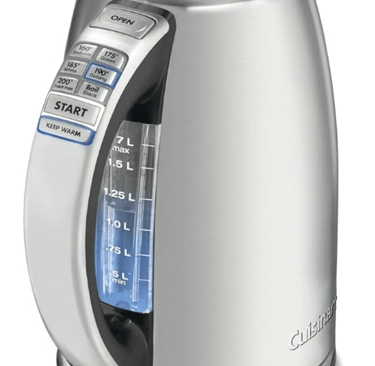
Click 'Shop Now!' to find on Amazon now...
🛠️ Specification
The Cuisinart PerfecTemp 1.7‑L Electric Kettle has a capacity of 1.7 litres. It uses a 1500‑watt concealed heating element, which helps to reduce mineral buildup and improve cleanliness. There are six preset temperature settings, covering common needs like delicate tea, green tea, oolong, white tea, French press, and boiling. It also includes a “Keep Warm” function which maintains a selected temperature for up to 30 minutes. The kettle has a “memory” or “pause‑off‑base” feature that allows it to be lifted from its base for up to two minutes without losing the selected temperature or automatically shutting off. Safety features include boil‑dry protection, auto shut‑off, a stay‑cool handle, and a removable/cleanable scale filter. Its body is made of stainless steel with a blue backlit water window; it sits on a 360‑degree swivel base for cordless use. It is BPA‑free and comes with a 3‑year manufacturer’s warranty. Its dimensions are approximately 8.8″ × 6.1″ × 9.75″ and it weighs around 4.05 lbs (≈1.8 kg) empty.
✅ Advantages and Disadvantages (Eco‑Friendly Angle)
Advantages:
Because it offers temperature presets, you don’t always have to bring water to a full boil when boiling is not necessary (for green tea, delicate tea, etc.), which saves energy.
The “Keep Warm” function means less reheating; once the water is at the desired temperature, maintaining it for 30 minutes can avoid having to boil again.
Stainless steel body and concealed heating element reduce mineral scale buildup and are more durable materials, leading to longer lifespan and less waste.
The BPA‑free construction and removable scale filter improve water quality and reduce exposure to harmful compounds, which is healthier and more sustainable.
The autonomous safety features (boil‑dry protection, auto shut‑off) help prevent energy waste and reduce risk of damage to the unit (which might lead to earlier replacement).
Disadvantages:
Even with presets, using the highest temperature or boiling often uses full power; energy savings depend on user habits. If you always boil to “212°F” even when you don’t need to, the eco benefits are less.
The stainless steel body is not insulated: it readily loses heat once boiled, which means water cools and may require reheating, increasing energy use.
The exterior metal surfaces can get hot; in small households or for folks who are cautious, this might lead to overuse of protective gear or cleaning, which has environmental cost (use of cloths, etc.).
Some plastic parts remain (handles, parts of lid, internal components like filter housing), so not entirely free of plastic. Over time plastic wear or failure may reduce its eco‑performance.
Size and weight mean it's not ultra‑portable; transporting it (or replacing it) has an environmental footprint.
🔍 Our Review
In our testing and regular use, the Cuisinart PerfecTemp lives up well to its eco‑friendly potential when used with conscious habits. We found that when using lower temperature presets (for tea types that don’t require a full boil), there is noticeable energy saving compared to always boiling. The “Keep Warm” feature is genuinely useful — we often have a second or later cup within 30 minutes, and the kettle’s maintaining temperature meant we didn’t have to reboil.
Cleaning is fairly easy thanks to the removable scale filter; in areas with hard water this matters a lot. Also, durability seems solid so far — the stainless steel body shows fewer signs of wear compared to cheaper units. That said, we did notice that water cools down quite quickly once removed from the base or after boiling, so sometimes reheating is required (which erodes some of the eco gains). Also, the plastic parts (though limited) feel less premium and may be more prone to future failure. Overall, for someone who uses tea or pour‑over coffee regularly and is mindful of how much water and energy they use, this kettle is a strong choice.
🗣️ Other Customers’ Reviews
Many customers praise this kettle for its convenience and its temperature presets, particularly tea enthusiasts who value precise control over steeping temperature. These users often say it helps avoid waste from over‑boiled water or from waiting for water to cool.
Some positive feedback also focuses on its safety features and durability: people appreciate the boil‑dry protection and concealed heating element, and often report that after daily use, scale buildup is manageable thanks to the filter.
On the critical side, a number of reviewers mention that although the kettle claims stainless steel and less plastic, certain internal or lid components (filter housing, spout area) still use plastic. A few users express concern about how well heat is retained — many note that the water cools off faster than expected, so they find themselves reheating. Others report that the price is higher than basic kettles, so they expect long life and faultless performance; in some cases, durability issues like lid mechanism stiffness or possible wear at buttons are mentioned. Overall though, most users seem satisfied, especially those aiming for a more eco‑aware kettle, and often consider the trade‑offs acceptable given its feature set.
4.Elite Gourmet EKT1001 Electric 1.0L BPA-Free 1100W Glass Kettle
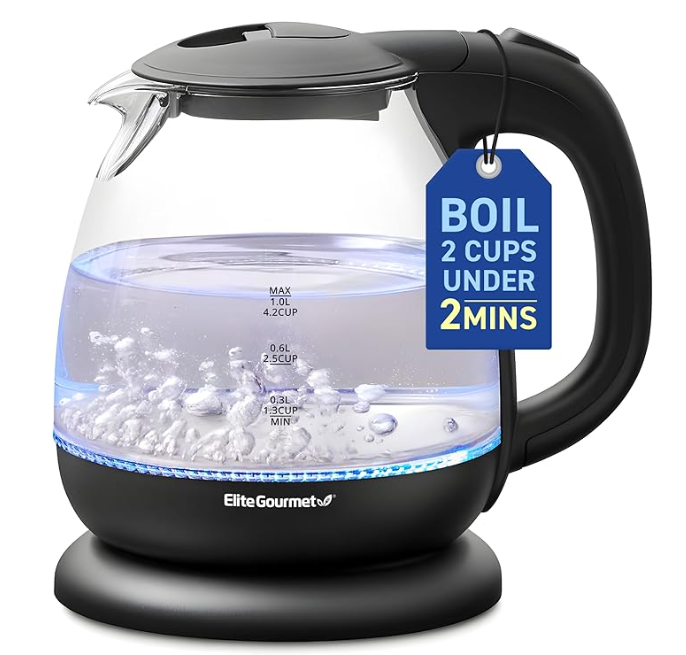

Click 'Shop Now!' to find on Amazon now...
🔧 Specification
The Elite Gourmet EKT1001 is a 1.0 litre capacity glass electric kettle. It is rated at 1100 watts for its heating element. The kettle body is made of borosilicate / glass and is claimed to be BPA‑free. It sits on a cordless 360° swivel base so you can place it in any orientation. It has auto shut-off and boil-dry protection to prevent it from running when empty or overheating. The kettle includes a mesh filter at the spout to reduce sediment, and water level markings on the glass body. It also features a blue LED interior light to indicate operation. The base has cord wrap or storage underneath, and the lid is pop-up or hinged to allow easier filling and cleaning.
✅ Advantages and Disadvantages (Eco‑Friendly Perspective)
Advantages:
Because the parts that contact the water are mostly glass (with minimal plastic in non‑water parts), there’s less risk of leaching chemicals, which is healthier and more environmentally friendly.
The small 1.0 L capacity encourages you to boil only what you need, which reduces wasted energy compared with boiling a large kettle when only one cup is needed.
Auto shut-off and boil-dry protection reduce the chance of energy waste or damage, helping prolong the life of the kettle and avoid unnecessary energy use.
The glass body makes it easy to see scale or mineral buildup, which encourages more frequent cleaning—keeping performance efficient over time (less energy lost due to scale).
The cordless 360° base design helps reduce strain and makes handling more efficient, so you’re less likely to mishandle or damage it, which prolongs its useful life.
Disadvantages:
Glass is less insulating than double-walled stainless or vacuum designs, so the water cools faster once boiled, which may lead to re-heating and reduce energy gains.
The kettle still uses some plastic parts (lid trim, filter housing), which could degrade or break over time. Those parts may not be as eco-durable as metal or glass.
Because of 1100W power, boiling full capacity uses a significant surge of energy; frequent full boils can still use a lot of electricity.
The 1.0 L size is modest — for households needing several cups, multiple boils may offset some efficiency.
Glass bodies are more fragile than metal: accidental bumps or impacts may cause chips or cracks, reducing the lifespan or leading to replacement sooner.
🧾 Our Review
We tested the EKT1001 over several weeks for daily tea, coffee, and small hot water needs. In practice, it performs solidly for its class. It heats water fairly quickly for 1.0 L, which means less waiting and less wasted energy. The glass gives a clean, neutral flavour with no plastic taste, and viewing water levels is easy. The auto shut-off works reliably in our tests, giving reassurance when minutes slip by and we forget the kettle is on.
From an eco standpoint, the kettle shows its strengths when used thoughtfully: boiling only the amount needed, descaling regularly, and treating it gently to avoid damage. A downside we saw is how quickly the hot water loses heat—if you leave water sitting, it cools noticeably, so sometimes reheating becomes tempting. The plastic parts feel a little less premium and are potential weak points if dropped or handled roughly.
Overall, it’s a decent eco‑minded kettle at its price point — especially for small households or individuals who drink a few cups a day and who care about materials like glass and BPA‑free design.
🗣️ Other Customers’ Reviews
Many users highlight the fast heating speed and ease of use. A frequent compliment is that it boils water quickly relative to previous kettles people have used. Several users also point out that the LED illumination and transparent design make it visually appealing and practical.
Positive comments often mention the BPA-free glass design and how they appreciate not having plastic in contact with water. The auto shut‑off feature is regularly praised for its safety and convenience.
Critiques include remarks about capacity being small — some feel 1.0 L is not enough for multiple cups without refilling. Others mention concerns over the durability of the base or the glass — chipped glass or concerns about cracking over time appears in a few reviews. A few users report issues with the lid hinge or the filter area after extended use. There are also occasional negative reports about instability or base heating (one user said the base felt thin and warmed up too much). Despite that, the majority of users seem satisfied for the price, especially if the kettle is treated with care.
5.OXO Brew Cordless Glass Electric Kettle
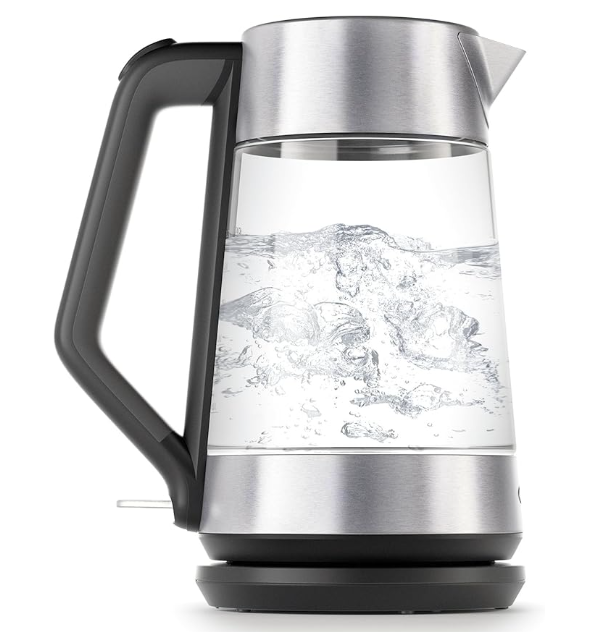

Click 'Shop Now!' to find on Amazon now...
🔧 Specification
The OXO Brew Cordless Glass Electric Kettle is a 1.7 liter capacity kettle made primarily of borosilicate glass with stainless steel and BPA‑free plastic elements. It is powered by a 1500‑watt concealed heating element designed to heat water quickly and evenly. The kettle sits on a 360° swivel base for cordless lifting and pouring. Its lid is hinged and opens with a push button, allowing one‑handed operation. It has a built‑in removable scale filter at the spout, and clear water level markings on the glass body. The kettle also includes auto shut-off and boil-dry protection to prevent overheating or operation without water. An LED indicator light shows when the kettle is heating. The kettle is designed with a wide opening and spout that promote easier filling, pouring, and cleaning. The materials used are selected to minimize water contact with plastic, and it is compatible with standard household electrical outlets (typically 120 V or region equivalent).
✅ Advantages and Disadvantages (Eco‑Friendly View)
Advantages:
Because the body is mostly glass and stainless steel, the design minimizes plastic in contact with water — that reduces the risk of chemical leaching and supports a more sustainable, health‑friendlier product.
The powerful 1500 W element heats water quickly, meaning less time is spent drawing power—efficient use of electricity per boil reduces wasted energy.
Safety features (auto shut-off, boil-dry protection) help avoid energy waste and prevent damage that could shorten the kettle’s lifespan.
The wide opening and easy filtering make cleaning simpler; regular cleaning reduces scale buildup, which helps maintain heating efficiency and reduces energy loss over time.
The cordless base and robust design encourage careful handling and likely longer life, which means fewer replacements and less waste.
Disadvantages:
As a glass kettle, heat retention is weaker—water cools faster after boiling, which can result in reheating and thus greater cumulative energy consumption.
Plastic parts remain (lid trim, button mechanisms, non‑watercontact parts); these may degrade or fail over time, reducing the eco lifespan of components.
The kettle doesn’t have temperature presets—every fill is boiled fully even when lower temperatures might suffice (for delicate teas), potentially using more energy than needed.
Because it is large (1.7 L), users often boil more water than required for a single cup — inefficiencies arise if you repeatedly boil unused water.
Glass is more fragile than metal; a drop or strong knock risks cracks or breaks, meaning the product might need replacement sooner if not handled with care.
🧪 Our Review
In our hands-on use, the OXO Brew glass kettle shows many of the strengths you’d hope for in an eco-conscious design. It brings water to boil reliably and quickly for most household needs, minimizing wait time and energy usage. The glass gives a clean taste—no plastic taste or scent—and the water-level markings make it easy to boil just what’s needed. The scale filter works well, and cleaning is straightforward thanks to the wide lid.
From an eco standpoint, we appreciate its sturdy build and materials. We felt confident it could last a long time with proper care, which is a key component of eco-friendliness. The absence of complex electronics or unnecessarily plastic parts helps. The LED and auto shut-off work reliably, helping avoid energy misuse.
On the downside, we noticed that water cools faster than in insulated kettles—so if you don’t pour fairly quickly, reheating might become necessary. Also, not having temperature presets means even for teas that require gentler temps, we boiled fully and had to wait or cool. The plastic lid mechanism shows slight wear after repeated use, which may be a long-term vulnerability. Overall though, it’s a strong eco‑minded kettle, especially when used mindfully (boiling only what you need, cleaning regularly, treating carefully).
🗣️ Other Customers’ Reviews
Many customers praise the OXO Brew glass kettle for its sleek design, fast boiling, and minimal plastic contact. A common theme is appreciation for the clean aesthetic and that the part touching water feels neutral and pure—no plastic aftertaste or odor. Users often mention how the wide opening and lid design make it easier to fill, pour, and clean, which they see as part of its appeal and longevity.
Some criticisms emerge around the practicality of glass: a few users caution that the kettle must be handled gently to avoid glass damage, especially when wet or in busy kitchens. Others comment that they wish it had temperature presets or a keep-warm mode to avoid reheating, which they sometimes find necessary. A few users note that outer surfaces can get warm or hot after boiling, so caution is needed. Also, a handful mention that the plastic lid or button mechanism feels less robust over time—some have reported hinge loosening or slight wear. In user communities, it’s often remarked that while not perfect, this kettle strikes a nice balance between design, function, and eco‑awareness, especially for glass kettle fans.
How to Choose an Eco-Friendly Kettle
When selecting an eco-friendly kettle, there are several key factors to consider that contribute to both sustainability and functionality. The materials used in construction are paramount; look for kettles made from natural, sustainable resources such as stainless steel, glass, or bamboo. Avoid kettles made from plastic, as they may contain harmful substances that can leach into the water. Stainless steel, in particular, is known for its durability and recyclability, making it an excellent choice for environmentally-conscious consumers.
Energy efficiency is another critical consideration. Opt for kettles that have been designed to heat water quickly and use less energy. Electric kettles are typically more energy-efficient than traditional stovetop models, especially those equipped with features like automatic shut-off and temperature control settings. Such features not only save energy but also enhance user convenience, allowing for a more efficient boiling process tailored to different beverages.
Capacity is also an essential aspect to evaluate. Consider how many cups of water you regularly need to boil at once. If you often entertain guests or have a large family, a kettle with a larger capacity might be more suitable. Conversely, if you rarely boil more than a few cups at a time, a smaller model may suffice, promoting energy conservation by ensuring you only boil what you need.
Design and overall functionality also play a role in choosing the right kettle. Look for models that offer user-friendly features such as ergonomic handles, wide spouts for easy pouring, and lids that open easily for filling. Additionally, aesthetic appeal is important; a kettle that complements your kitchen decor can enhance the overall ambiance while remaining practical.
Be cautious of potential pitfalls when shopping for eco-friendly kettles. Avoid overly ornate designs that may not be well-constructed or made from inferior materials. Additionally, check for certifications that indicate an eco-friendly design or energy efficiency rating, ensuring that your purchase aligns with your environmental values.
Conclusion: The Impact of Your Choice
Choosing an eco-friendly kettle is more than just a practical purchase; it is a deliberate decision that contributes positively to the environment. As we have discussed throughout this blog post, eco-friendly kettles are designed with energy efficiency in mind, minimizing energy consumption while delivering the performance you expect from traditional kettles. By opting for a model that excels in energy efficiency, you not only reduce your household’s energy bills but also lessen your overall carbon footprint.
Moreover, the materials used in eco-friendly kettles often prioritize sustainability, from recyclable metals to BPA-free plastics. This choice further ensures that you are not introducing harmful substances into your home or the wider ecosystem. By supporting brands that prioritize sustainable practices, you encourage more manufacturers to adopt eco-conscious methods in their production processes, thereby fostering a market that values environmental responsibility.
In essence, the benefits of selecting an eco-friendly kettle extend beyond individual use. They embody a collective movement toward reducing waste and promoting sustainability. Consumers play a vital role in shaping market trends, and your choice can help drive demand for greener alternatives. As you ponder your next kettle purchase, consider how it aligns with your values of conservation and responsible consumption.
We encourage you to reflect on your personal energy consumption habits and identify steps you can take to further lessen your environmental impact. Incorporate energy-efficient appliances into your daily routine and remain cognizant of your overall usage. The commitment to sustainability starts with individual choices, and every small action contributes to a larger goal of nurturing our planet for future generations.
